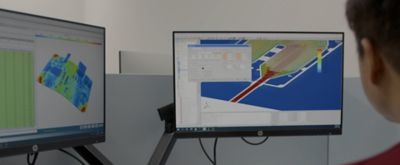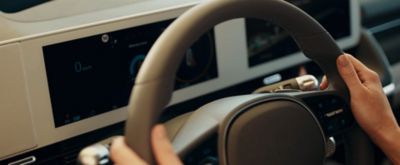ANSYS BLOG
February 1, 2024
Making Sense of the Road Ahead with Simulation
In the latest episode of "Driven by Simulation," HL Klemove, Continental, and 3M show how they are developing amazing autonomous vehicle technologies and improving comfort while rigorously assessing risk to help ensure safety.
Imagine a world where there are zero vehicle accidents. It's a prospect that should have everyone cheering. According to the World Health Organization, approximately 1.19 million people die each year as a result of road traffic crashes.
So how do we go from 1.19 million to zero? Ansys customers HL Klemove and Continental are betting on autonomous technology to save the day. And they aren't the only ones. By taking the driver out of the equation, many industry insiders believe fully autonomous vehicles have the potential to make our travels much safer.
How far we go to achieve this goal depends on a high level of coordination and connectivity. All of this functionality — from vehicle alerts and navigational maps to diagnostics and data downloads — is lighting up our vehicle interiors to the point of distraction, which is where 3M is stepping in, and stepping up to soothe our senses.
Let's see how the companies featured in the latest episode of "Driven by Simulation" — HL Klemove, Continental, and 3M — are shaping driving experiences of the future that will help keep us safe, comfortable, and connected, wherever we go.
Simulation Accelerates How HL Klemove Takes AVs from Sensing to Thinking, and Thinking to Moving
Autonomous driving is fundamentally a matter of safety and perception. From there, the journey to fully automated driving gets a bit more complex. How do you train a vehicle to successfully replicate human behavior and decision making in response to its immediate surroundings?
Autonomous function at any level is enabled by a collection of sensors, including radar, lidar, and cameras. They all work together to gather data that will then be used to interpret the environment and support the machine learning that ultimately enables self-driving.
Unlike many automotive suppliers who focus on a specific aspect of autonomous functionality, HL Klemove aims to cover all bases with assistance from simulation. Its offerings include radar, camera, and lidar sensing technologies; autonomous driving control units and software stacks; and chassis control units.

HL Klemove develops a number of autonomous vehicle technologies.
"As a leading total solution provider in autonomous driving, we present autonomous driving roadmaps to full-fledged automakers and grow together with them," says Hanyeol YU, Head of the AD Sensor Center at HL Klemove. "We're on the brink of supplying level 3 autonomous driving components to major customers, making a significant milestone in our journey. We consider Ansys in this sense to be a crucial partner that helps us adapt to such industry changes. Ansys enables us to minimize time and resource inputs while preparing for various scenarios through simulations."
HL Klemove employs a range of Ansys solutions daily to meet its ambitious development objectives. These include Ansys HFSS for full wave 3D electromagnetic (EM) simulations, Ansys Icepak for cooling simulations, Ansys Mechanical for structural analysis, Ansys Sherlock for complete electronics life prediction, and Ansys Speos for optical system design and validation.
As a key supplier for global automakers, the engineering team at HL Klemove constantly strives to develop solutions that original equipment manufacturers (OEMs) can depend on for safety and comfort on the road. The company relies on Ansys' profound expertise in automotive technology to achieve this.
"Actually, today I am working on the verification of the radar by comparing simulation results to the tests," says Yunsu Kang, Senior Engineer at HL Klemove. "Let's say that verification is a kind of tendency verification process, which means that there are different signals of movement of radar which cannot be reproduced each time we run a test. So, we utilize Ansys tools so that we can check if the test results are coinciding with the result of the simulation that we can expect."

HL Klemove employs a range of Ansys simulation solutions.
Continental's "Twinning" Strategy Helps Set the Future of Self-Driving Technology in Motion
With all this momentum behind self-driving tech, when exactly will we achieve full autonomy? Continental is encouraging customers to be patient — automation is coming. The automotive technology company is combining its experience with the power of simulation to develop more technologies to do the driving for us.
Navigating traffic jams, fitting into tight parking spaces, and advanced driver assistance systems (ADAS) are all examples of how automation will intervene to make our trips safer, and more enjoyable. And, if we're yearning to take the wheel, we'll still have the power to turn all of these systems on or off at the press of a button.
Simulation is helping Continental to drive these trends forward in the development of new sensor technologies and high-performance computer systems that will support advanced driver-assistance systems (ADAS) functions now, and well into the future. Engineers at Continental are relying on Ansys optiSLang to facilitate the creation of digital twins and test assumptions about various aspects of its forward-looking technology.
A digital twin is a virtual representation of real-world entities and processes, synchronized at a specified frequency and fidelity. They use real-time and historical data to represent performance past and present, and simulate future predicted outcomes. To this end, optiSLang enables Continental to create and deploy digital twin models that can predict system failures, anticipate required maintenance, or identify the value of unlocking existing assets.
"We do use simulation, which is already great," says Laura Lindner, Simulation Engineer at Continental. "… And as you know, the simulation run takes a couple of hours … So, if we want to change input parameters (of our digital twin) now, we don't have to run a whole simulation again, we can just change the values and get back the results within seconds. So, this helps us a lot, especially in the development phase because we can sit down with the other engineers and look through the different design configurations really fast."
With so much riding on this new and emerging tech, the speed and agility of simulation-driven testing enables Continental engineers to understand the increasing complexity of the solutions they are developing. Ansys optiSLang facilitates faster testing yielding more information, and more certainty at a speed that will not only save costs, but potentially lives as well.

Continental testing their autonomous technologies
Simulation Helps 3M Optical Films Shine in Automotive Interior Lighting Applications
For the foreseeable future, vehicle infotainment system technology will continue to dominate the automotive interiors market as a function of our connected world. Naturally, as autonomous functionality evolves, this level of connectivity will also enable data sharing that helps ensure our vehicles are performing as they should in real-time.
Automotive displays act as in-vehicle command centers, informing and shaping our drive time. And much of the activity recorded and displayed on the vehicle dashboard or head-up display is communicated through lighting, and lots of it, which can be quite distracting for all vehicle occupants.
3M, a global leader in science and innovation, is contributing to this technological wave with advanced optical films. 3M's prismatic, multi-layer optical films, when applied to in-vehicle displays and other light element surfaces, help maximize brightness and contrast while controlling distracting reflections. In the application of these products, the goal is to create a cockpit environment that soothes, rather than bombards the senses with light.

A dashboard using 3M optical films
"Every cockpit design requires a different kind of display design, and making sure that we can enhance the readability of that display," says David Ylitalo, Vice President of Research and Development at 3M. "Depending on where it is in the cockpit, how big it is, what curvature it has — all of these things require us to customize a design for our optical films that enhances driver safety and comfort and so on."
To optimize its optical films, 3M needs to know where the light is going. This requires an understanding of the propagation of light, or how the light from in-vehicle displays travels through various mediums and materials within the cockpit of a vehicle. Ansys optical simulation solutions help 3M discern, through ray tracing and other activities, how the human eye will ultimately perceive this activity, and then apply this knowledge to develop future film technology.
In gaining a sense of perspective through simulation, 3M also saves precious time during development.
"With virtual prototyping you can totally save cost and time because you're using virtual prototypes to replicate a real scenario before the design is even final, so you can work on your design very early on," says Jincy Jose, Advanced Product Development Specialist at 3M. "(The) materials and even the placement of your displays and other lit elements can be finalized early on in the design process and thereby create a safer environment for the drive."
Tune in for More.
If you haven't seen the latest episode of Ansys online docuseries "Driven by Simulation," it's a great opportunity to hear more from our customers on their success with simulation in advancing autonomous vehicle development.
